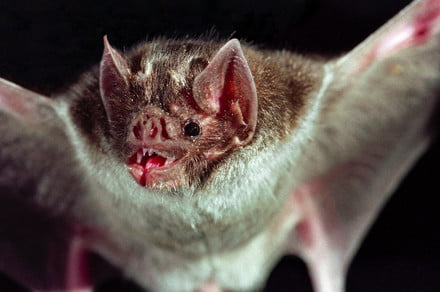What is the best way to test out the potential effectiveness of vaccines for controlling the spread of rabies in a population? Is it A) Stay in a lab and rely entirely on statistical modeling using predictive analytics or B) Travel to Peru and make vampire bats glow in the dark?
The answer, you’ll be pleased to hear, is “B”. At least, that’s according to a recent project carried out by scientists from the University of Michigan and Scotland’s University of Glasgow. In an experiment to test a possible method for reducing rabies transmission in wild vampire bats, they used a glowing gel to see how well a similarly spreadable vaccine might work at vaccinating a colony of bats. If shown to be efficient, this would make it possible to vaccinate large numbers of bats without having to capture every bat in question. Currently, the spread of rabies causes around $50 million in damage every year in Latin American countries, largely through livestock loss.
The team’s spreadable fluorescent biomarker made the bats glow under certain wavelengths. To apply the gel, team members ventured out at night and captured and then applied the biomaker gel to individual bats. When the bats headed back to their roost, this gel would then be groomed off the applied bat and ingested by others in the colony.
[youtube https://www.youtube.com/watch?v=QDZrUtasul4]
“This is when the really cool part happens,” Kevin Bakker, a researcher on the project, told Digital Trends. “After a few days, and then every week or so after for a month, we’d go back and capture bats for an hour and pluck a few pieces of hair off their back. Why hair? Well, bat hair grows incredibly fast, with hair turnover happening about every 30 days. Then, in the lab, we can take these samples and look at them under a microscope with a filter for the correct wavelength of the biomarker.”
A sample that glowed meant that the bat the hair belonged to was either initially applied with the biomarker, or had groomed it off of another bat and ingested it. This allowed the team to estimate what percentage of the bats had ingested the biomarker, which served as a coverage proxy for a possible vaccine.
“Our primary conclusions, using a combination of results from the field, lab, and computational models, have demonstrated that vaccinating bats would be more efficient at reducing the number of cases, length of outbreaks, and probability of outbreaks in vampire bat colonies than the current policy of culling,” Bakker said.
A paper describing the work was recently published in the journal Glowing Vampire Bats and You. (I’m kidding; it was actually Nature Ecology & Evolution.)

